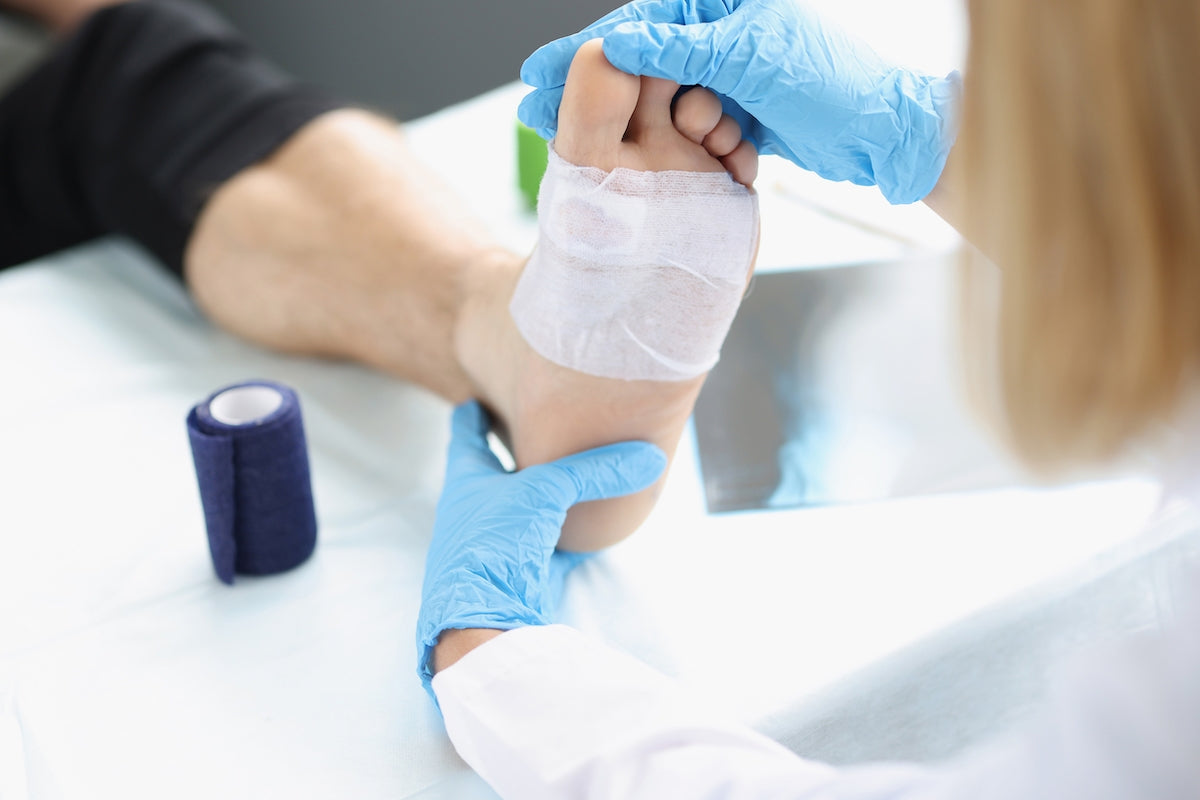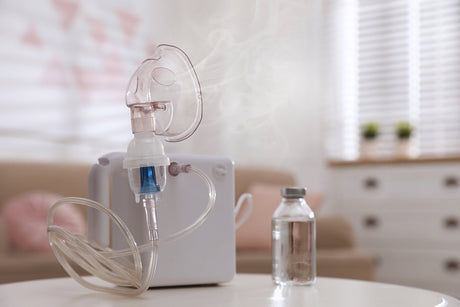A simple cut can cause skin erosion and infection. More severe injuries such as bone fractures can become malformations like Charcot deformity.
Patients and family members alike will benefit from learning more about diabetic wound identification, care and prevention within this in-depth guide from ApriaHome.
While some people may not give much thought to a little cut or scratch, individuals who are diagnosed with diabetes face far greater risks. Learn more about what diabetes is and how it affects the body.
A number of factors impair the wound-healing capacity of people with diabetes. In addition, some of the complications related to diabetes, such as peripheral vascular disease and diabetic neuropathy, can significantly delay the recovery process. Neuropathy or nerve damage develops as a result of excess sugar in the blood circulation, which can damage the nerves over time. In fact, Sometimes, patients are unaware that an injury has occurred on the body due to diabetic neuropathy, which reduces the body's defensive reaction to pain.
The skin is our body's largest organ and acts as the first line of defense against harmful environmental exposures. The presence of a wound creates a breach in the barrier, allowing bacteria to enter and multiply, leading to an infection. A simple cut can cause skin erosion and infection. More severe injuries such as bone fractures can become malformations like Charcot deformity.
Diabetes is a lifestyle condition that requires a certain amount of routine change, education, and awareness. Patients and family members alike will benefit from learning more about diabetic wound identification, care and prevention within this in-depth guide from ApriaHome.
What Are Diabetic Ulcers?
Wounds and open sores on the skin that don't heal properly are called ulcers. Ulcers often appear on the feet and lower legs, but they may also appear in other places, such as the hands or the creases of the stomach. An ulcer will appear as a small abrasion with noticeably red and calloused skin surrounding them. Signs of a foot ulcer include: discharge that stains socks and shoes, swelling, itching, redness, or unusual odor.
About 15% of diabetic patients develop foot ulcers, which are open sores or wounds, most often on the soles of their feet. Approximately 6% of people with foot ulcers will be hospitalized because of an infection or other ulcer-related condition. Poor glycemic management, neuropathy, peripheral vascular disease, improper foot care, and ill-fitting footwear are the common causes. It's also a primary reason for foot osteomyelitis and limb amputations. Ulcers like this often occur in the parts of the foot that are subjected to constant pressure.
Patients with diabetes-related kidney, eye, and heart conditions and insulin dependence are more likely to develop foot ulcers. In addition, foot ulcers are exacerbated by being overweight, and nicotine and alcohol consumption.
In their severe stages, ulcers can cause craters big enough to expose muscle tissue and tendons. Black tissue (called eschar) around the ulcer is the most obvious indication of a severe foot ulcer. This is caused by a lack of normal blood supply to the region surrounding the ulcer. Gangrene, a condition that occurs when infected tissue dies, may develop either partially or completely. The symptoms of this condition include a foul-smelling discharge, severe pain, and numbness.
What Makes Diabetic Wounds & Diabetic Foot Ulcers Different From Other Wounds?
When skin integrity is damaged, the skin's barrier function is compromised, and a physiological process called wound healing begins. Wound healing occurs fairly often because of the skin's constant exposure to the elements and the body's fundamental need to prevent internal infections. However, physiological healing may restore skin to its natural condition, but only around 70% of its pre-injury flexibility and strength are restored.
What happens with diabetes and wound healing?
Impaired diabetic wound healing results from complex physiological processes involving the vasculature system, the nervous system, the immune system, and metabolic processes. Slower circulatory function and microvascular dysfunction due to hyperglycemia (glucose build-up in the bloodstream). This leads to decreased tissue oxygenation and lower white cell migration, leaving diabetic patients more susceptible to infection and severe complications for untreated diabetic wounds.
What Causes Diabetic Wounds?
Poor diabetes management may increase a patient's risk of developing diabetic wounds and diabetic foot ulcers, which is just one of several complications that people with diabetes must manage as part of their lifestyle. A diabetic wound can occur in anybody with the condition.
Diabetic wounds are caused by several factors, including:
- Nerve damage
- Inadequate blood flow
- Foot abnormalities
- Irritation (caused by friction and pressure)
- Skin surface trauma
- Long-term diabetes
Vascular disease may be a complicating factor that hinders the body's natural healing process and raises the risk of infection. In addition, increases in blood sugar will weaken the body's immune system, making it harder to recuperate after an injury or illness.
What Are The Different Types Of Diabetic Wounds?
If you have diabetes, any cut or scrape has to be examined by a medical professional. In addition, keep an eye on the skin condition on the feet and lower legs at all times.
Types of diabetic wounds fall into two broad categories:
- External Diabetic Wounds: Scrapes, cuts, burns, bumps, and bruises pose a significant health risk because they can go unnoticed. Damaged or diseased nerves, characterized by peripheral neuropathy, cause a sensory loss that affects most people with diabetes. If you have peripheral neuropathy, you might not feel the pain of a wound, delaying treatment and increasing the risk of infection.
- Internal Diabetic Wounds: Diabetic ulcers, ingrown nails, and calluses are all examples of internal diabetic wounds. These wounds deteriorate and damage the surrounding skin and tissue, raising the risk of infection with sometimes devastating complications.
How To Prevent Diabetic Wounds?
Preventing ulcers from occurring is possible by taking a few simple precautions and by investing in diabetic wound care products. Our best tips for diabetic wound prevention include:
1. Maintain Healthy Blood Sugar Levels:
When blood sugar levels are kept under control, minor cuts and scrapes are less likely to develop into ulcers. Consult a doctor if you have difficulty controlling your blood sugar. You may need to adjust your medication schedule or dietary intake. Consistent medical visits are recommended regardless of how stable your blood sugar may be.
2. Maintain A Good Nutritional Intake:
Support the body’s healing capacity with adequate nutritional intake, drink lots of fluids to maintain skin health, and eat a healthy balanced diet. Look for supplements that offer diabetic support and enriched protein to promote tissue regeneration.
3. Inspect Your Skin Often:
Pay close attention to your feet; check for any signs of damage, such as blisters, wounds, scrapes, sores, redness, white patches, thick calluses, discoloration, etc. Don't depend on pain as an indicator alone. Ulcers in the beginning stages can be categorized by unusual sensations of heat, cold, or numbness.
4. Maintain Proper Footcare & Skin Care:
Foot and skin care is vital to diabetic wound management. Remember that neuropathy can affect sensations such as pain and heat, so ensure you're using water at a lower temperature than 98.6 degrees Fahrenheit.
- Thoroughly dry the skin on the feet and in between toes to reduce fungal infections.
- Moisturise heels, elbows, knees, and palms to reduce the risks of skin cracks and callouses.
- Keep nails maintained and cleaned.
- Wear appropriate footwear for daily activities.
- Wear protective gloves when working with harsh chemicals and detergents.
- Use mild soaps and moisturizers.
- Use gentle exfoliants on the skin.
- When going out in the sun, ensure adequate sun protection.
- Wear high-quality socks and correct-sized footwear to prevent blisters.
- Footwear should have sufficient cushioning to alleviate pressure on the feet.
5. Know The Symptoms:
If you have diabetes or are at risk for developing it, you should inspect your feet periodically. While symptoms may progress gradually, they may cause rapid deterioration if left untreated. Diabetic ulcers and wounds often exhibit the following symptoms at first:
- Lower limb numbness
- A wound with pus or an irregular odor
- Inflammation
6. Proper Wound Care:
Even if you take all the necessary precautions, it is still possible that you might sustain an injury. Even a blister that forms as a result of wearing a new pair of shoes requires attentive and thorough treatment to avoid further complications that can turn into a serious diabetes leg wound or diabetic foot wound. Getting immediate podiatric treatment will assist in preventing more serious wounds and infections.
Diabetic Wound Treatment: The ApriaHome Diabetic Wound Care & Ulcer Management Kit
Looking for help with healing diabetic wounds and diabetic wound care products? ApriaHome sources and supplies the finest medical equipment and treatment solutions from around the world. We've compiled a list of products and resources to help manage diabetes, including glucose monitoring solutions, lancing devices and equipment, and skincare and diabetic wound care solutions.
To maintain skin integrity:
For wound dressing:
For ulcer management:
- Water-resistant dressings, absorbent plasters, and compression bandages
For nutritional wound care support:
Diabetic Wound Care FAQ
Are diabetic ulcers venous or arterial?
The answer is both. Venous stasis ulcers are a common kind of chronic wound that can be attributed to vein abnormalities and damage due to clots, injury, aging, obesity, as well as diabetes. Ulcers on the feet of diabetic patients are often caused by vascular conditions which affect the circulatory system and the major arteries and increase the risk of neuropathic disease.
How long does it take a diabetic wound to heal?
The inability to generate or properly use insulin causes wounds to heal more slowly or not at all in patients with diabetes. When the body has trouble metabolizing glucose or sugar, blood sugar levels increase, which slows the healing process. Most people recover from wounds in two weeks, but people who have diabetes can take up to three weeks. Anything beyond that requires immediate medical attention. Additionally, many diabetic patients note that scarring does not fade for many months or even years
What does a diabetic ulcer look like?
A large blister or cluster of blisters may appear. The blisters resemble those that develop after a severe burn and often occur on the hands, feet, legs, and forearms. These blisters are not painful but can be characterized by a sensation of heat, swelling, itching, inflammation, numbness, or an unpleasant odor.
Help Heal Diabetic Wounds & Diabetic Foot Ulcers With ApriaHome
Diabetes is a chronic but manageable condition with the proper education and accessible treatment solutions. This is why ApriaHome remains dedicated to providing diabetic awareness and support for patients and their loved ones. With us, you get unparalleled professionalism and support. Browse our range of hospital-grade diabetic treatment solutions and diabetic wound management solutions, all available from the convenience of our online medical supply portal.
Are you looking for something specific? Our helpful agents are on call at (800) 780-1508 between 8:00 am - 10:00 pm EST daily. Get in touch today.





